
Chopin’s Prelude in E Minor‚ Op. 28‚ No. 4‚ is a deeply emotional and expressive piece‚ showcasing the composer’s mastery of subtlety and nuance. Widely available as sheet music in PDF format‚ it remains a favorite among pianists and music enthusiasts‚ offering a profound exploration of melody and harmony that continues to inspire performers and listeners alike.
Overview of the Piece
Chopin’s Prelude in E Minor‚ Op. 28‚ No. 4‚ is a delicate and emotionally profound piece‚ characterized by its slow tempo and expressive melody. It is part of Chopin’s set of 24 Preludes‚ each written in a different key‚ showcasing his mastery of musical expression. The piece is marked Largo‚ indicating a slow and contemplative pace‚ which allows for deep emotional exploration. Its simplicity in structure belies the complexity of its harmonic and melodic nuances‚ making it a favorite among pianists and music enthusiasts. The prelude is often described as hauntingly beautiful‚ with a melancholic quality that resonates deeply with listeners. Its popularity endures‚ and it is frequently featured in media‚ films‚ and educational materials‚ further cementing its place in classical music repertoire.
Historical Context and Composition
Chopin’s Prelude in E Minor‚ Op. 28‚ No. 4‚ was composed during the 1830s‚ a period marked by Chopin’s growing recognition as a master of piano music. Written in Paris‚ this prelude reflects the composer’s deep emotional expression and technical innovation. It is part of a set of 24 preludes‚ each in a different key‚ showcasing Chopin’s harmonic ingenuity and sensitivity. The piece is characterized by its slow tempo‚ marked Largo‚ and its melancholic‚ introspective nature. Composed during a time of personal and artistic transformation‚ the prelude embodies Chopin’s ability to convey profound emotions through simplicity and subtlety. Its composition highlights Chopin’s unique approach to piano writing‚ blending lyrical melodies with intricate harmonies‚ leaving a lasting impact on classical music.

Structure and Musical Elements
Chopin’s Prelude in E Minor‚ Op. 28‚ No. 4‚ features a slow tempo marked Largo‚ emphasizing a deeply expressive melody and nuanced harmonic shifts in a minor key.
Musical Structure and Form
Chopin’s Prelude in E Minor‚ Op. 28‚ No. 4‚ is structured as a single movement with a clear beginning‚ middle‚ and end. The piece is written in a through-composed form‚ meaning it does not repeat large sections but instead develops organically. It begins with a somber melody in the E minor key‚ marked Largo‚ which sets a reflective and mournful tone. The structure is characterized by a gradual buildup of emotional intensity‚ followed by a resolution that returns to the initial mood. Chopin’s use of key modulations and harmonic shifts creates a sense of tension and release‚ while the consistent tempo and phrasing maintain a cohesive flow. This form allows for a profound exploration of the piece’s emotional and technical dimensions.
Key Signature and Tempo Marking
Chopin’s Prelude in E Minor‚ Op. 28‚ No. 4‚ is written in the key of E minor‚ which contributes to its somber and reflective character. The piece is marked Largo‚ indicating a slow and solemn tempo that underscores its emotional depth. The key signature of E minor‚ with one sharp (F♯)‚ sets a melancholic tone‚ while the largo tempo allows for a deliberate and expressive interpretation. This combination of key and tempo creates a hauntingly beautiful atmosphere‚ inviting pianists to explore the nuances of phrasing and dynamics. The sheet music reflects these markings‚ guiding performers to maintain the slow pace and emphasize the minor key’s inherent sorrow. Together‚ the key and tempo define the prelude’s mood‚ making it one of Chopin’s most poignant compositions.
Melodic and Harmonic Features
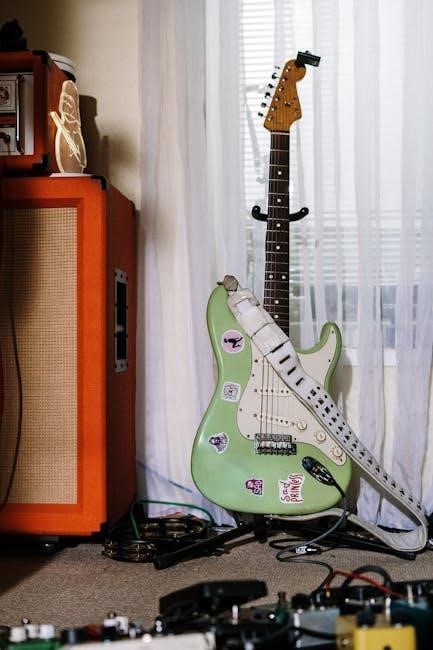
Chopin’s Prelude in E Minor‚ Op. 28‚ No. 4‚ features a delicate and sorrowful melody that unfolds over a simple but expressive harmonic foundation. The melodic motifs are characterized by their simplicity and emotional depth‚ allowing for rich interpretative possibilities. Harmonically‚ the piece employs chromaticism and unexpected modulations‚ adding layers of complexity and tension. The interplay between the melodic line and the accompanying chords creates a sense of longing and introspection. The harmonic structure‚ while sophisticated‚ remains accessible‚ making the prelude a favorite among pianists. The sheet music highlights Chopin’s mastery of balancing simplicity with depth‚ offering a profound exploration of melody and harmony that continues to captivate performers and audiences alike.

Sheet Music Availability and Sources
Chopin’s Prelude in E Minor‚ Op. 28‚ No. 4‚ is widely available as PDF sheet music from sources like Piano Street‚ Musicnotes‚ and FreeScores‚ ensuring easy access for pianists.
Free PDF Downloads for Piano
Chopin’s Prelude in E Minor‚ Op. 28‚ No. 4‚ is widely available as free PDF sheet music for piano. Websites like Piano Street‚ FreeScores‚ and MuseScore offer high-quality downloads. These sources provide clean‚ readable notation‚ ideal for both beginners and advanced pianists. The piece‚ composed in 1830‚ is part of Chopin’s iconic set of 24 preludes‚ each evoking distinct emotions. This prelude‚ marked Largo‚ features a somber and reflective melody‚ making it a popular choice for study and performance. Musicians can easily access and print these PDFs‚ ensuring they have the necessary resources to explore Chopin’s lyrical and harmonic genius. Free downloads are a convenient way to engage with this timeless work‚ fostering both practice and appreciation of classical music.
Edited and Annotated Versions
Edited and annotated versions of Chopin’s Prelude in E Minor‚ Op. 28‚ No. 4‚ are available for pianists seeking detailed guidance. These versions often include fingerings‚ dynamic markings‚ and performance notes from renowned pianists and scholars. Websites like Piano Street and MuseScore offer such editions‚ providing clarity and insight into Chopin’s intent. Annotated scores highlight intricate harmonies‚ phrasing‚ and pedal techniques‚ aiding interpretation. Some versions also include historical context‚ making them invaluable for both practice and performance. These resources are particularly useful for students and professionals aiming to master the piece’s emotional depth and technical challenges‚ ensuring a faithful and expressive rendition of Chopin’s timeless work.
Instrument-Specific Arrangements
Chopin’s Prelude in E Minor‚ Op. 28‚ No. 4‚ has been adapted for various instruments‚ expanding its reach beyond the piano. Guitarists can find fingerstyle arrangements in PDF and GuitarPro formats‚ offering intricate fingerpicking patterns that preserve the piece’s emotional depth. String quartet versions are also available‚ translating the prelude’s harmonic richness into a chamber music setting. Additionally‚ arrangements for solo instruments like the violin maintain the melody’s haunting beauty while adapting to the instrument’s capabilities. These versions allow musicians to explore Chopin’s masterpiece in ways that suit their instrumentation‚ ensuring the prelude’s legacy endures across diverse musical ensembles and performances.
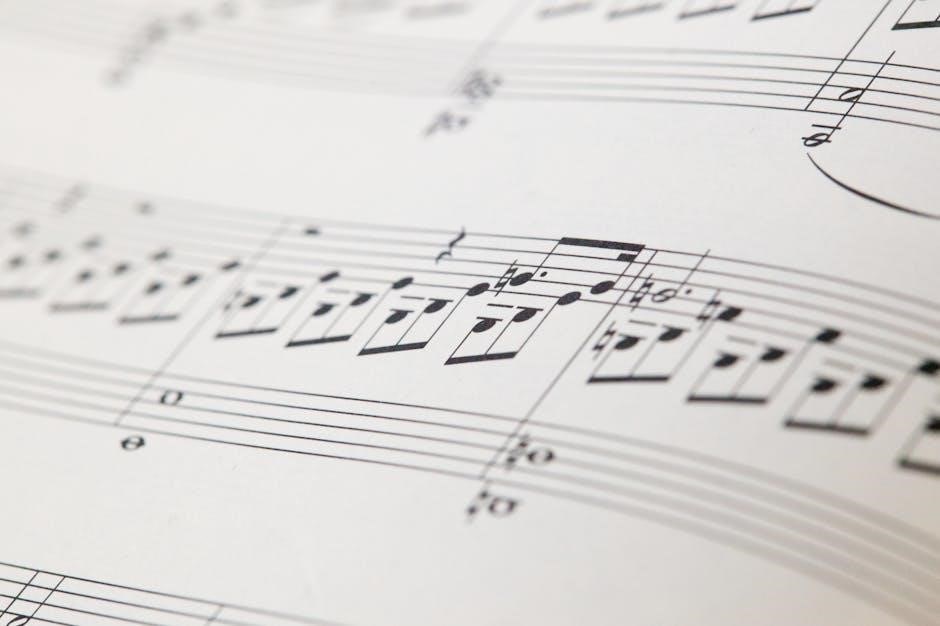
Performing and Interpreting the Prelude
Performing Chopin’s Prelude in E Minor demands precision and sensitivity. Pianists must balance technical skill with emotional depth to convey its delicate‚ expressive qualities effectively.
Technical Challenges for Pianists
Chopin’s Prelude in E Minor presents several technical challenges for pianists‚ including mastering the delicate Largo tempo and maintaining dynamic control. The piece requires precise finger dexterity to navigate its intricate melodies and harmonies seamlessly. Pianists must also pay close attention to the subtle shifts in phrasing and the expressive qualities demanded by the espressivo marking. Additionally‚ the nuanced balance between the left-hand accompaniment and the right-hand melody is crucial‚ as is the execution of the diminuendo passages that lead to the piece’s haunting conclusion. Achieving a cohesive and emotionally resonant performance demands both technical proficiency and a deep understanding of Chopin’s expressive intent.
Expressive Nuances and Dynamics
Chopin’s Prelude in E Minor is renowned for its profound expressive qualities‚ with dynamics and phrasing playing a central role in its emotional impact. The piece begins with a delicate‚ haunting melody marked espressivo‚ requiring pianists to convey deep feeling through subtle variations in touch and timing. The dynamic contrasts‚ from the soft‚ mournful opening to the brief‚ dramatic crescendo‚ add layers of tension and release. Chopin’s use of rubato and nuanced pedaling further enhances the piece’s expressive potential‚ allowing for a personalized interpretation of its melancholic beauty. The diminuendo toward the end creates a sense of fading away‚ leaving a lingering emotional resonance. These expressive nuances make the prelude a timeless masterpiece‚ inviting pianists to explore its rich‚ poetic depths.
Famous Recordings and Interpretations
Chopin’s Prelude in E Minor has been interpreted by countless pianists‚ each bringing their unique perspective to its haunting melody. Legendary pianists like Arthur Rubinstein and Krystian Zimerman have delivered deeply emotional recordings‚ capturing the piece’s mournful essence. Notably‚ the prelude has also been adapted by other artists‚ such as guitarist Jimmy Page‚ who performed it while smoking‚ adding a rebellious flair. These interpretations highlight the piece’s versatility and timeless appeal. Rubinstein’s version‚ in particular‚ is celebrated for its poetic sensitivity‚ while Zimerman’s offers a more introspective approach. Such recordings demonstrate how Chopin’s composition transcends traditional boundaries‚ inviting artists from diverse musical backgrounds to explore its expressive depths. Each interpretation remains a testament to the prelude’s enduring beauty and emotional resonance.
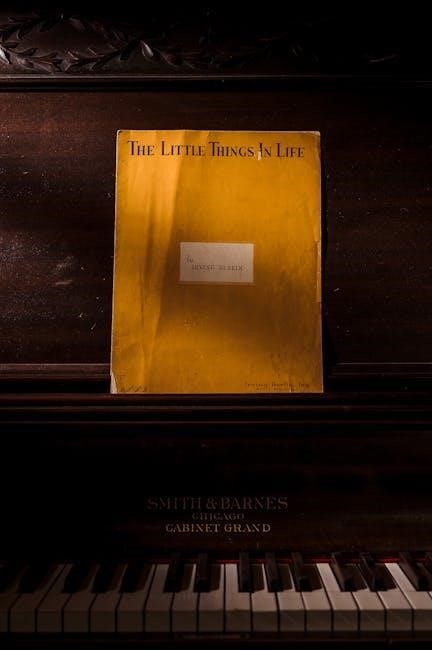
Educational Resources and Tutorials
Educational resources for Chopin’s Prelude in E Minor include piano tutorials‚ sheet music with fingerings‚ and practice guides‚ aiding pianists in mastering the piece effectively.
Piano Tutorials and Lessons
Piano tutorials for Chopin’s Prelude in E Minor are widely available‚ offering detailed guidance for pianists of all skill levels. Many tutorials provide step-by-step lessons‚ focusing on technical aspects such as finger placement‚ dynamics‚ and tempo control. Video tutorials‚ like those found on platforms‚ demonstrate the piece in its entirety‚ allowing learners to observe and mimic the performance. Additionally‚ some tutorials include annotated sheet music‚ highlighting key passages and expressive nuances. These resources are particularly useful for beginners seeking to grasp the piece’s emotional depth and structural complexity. Advanced players can also benefit from in-depth analyses of phrasing and interpretation. Overall‚ these tutorials serve as invaluable tools for mastering Chopin’s beloved prelude.

Sheet Music with Fingerings
Sheet music for Chopin’s Prelude in E Minor‚ Op. 28‚ No. 4‚ often includes fingerings to guide pianists in achieving optimal technique and expression. These markings‚ provided by experienced editors‚ help navigate the piece’s intricate passages and emotional nuances. Both beginner and advanced pianists benefit from such annotations‚ as they offer insights into phrasing‚ dynamics‚ and articulation. Many free PDF downloads and professionally edited versions include fingerings‚ making it easier for performers to master the prelude’s delicate melody and harmonies; These resources are invaluable for those seeking to refine their interpretation and technical accuracy‚ ensuring a faithful rendition of Chopin’s timeless work.
Practice Guides and Exercises
Practice guides and exercises tailored for Chopin’s Prelude in E Minor‚ Op. 28‚ No. 4‚ are essential for mastering its technical and expressive demands. These resources often include step-by-step tutorials‚ finger independence exercises‚ and tips for achieving the piece’s delicate legato and nuanced dynamics. Many online platforms offer downloadable PDFs with practice-specific annotations‚ while video lessons provide visual demonstrations of proper technique. Beginners can benefit from exercises focusing on chord progressions and arpeggios‚ while advanced pianists may explore intricate phrasing and rubato. Additionally‚ metronome exercises and slow-practice guides are recommended to build precision and control. These tools‚ combined with dedicated practice‚ help pianists unlock the prelude’s emotional depth and technical brilliance.
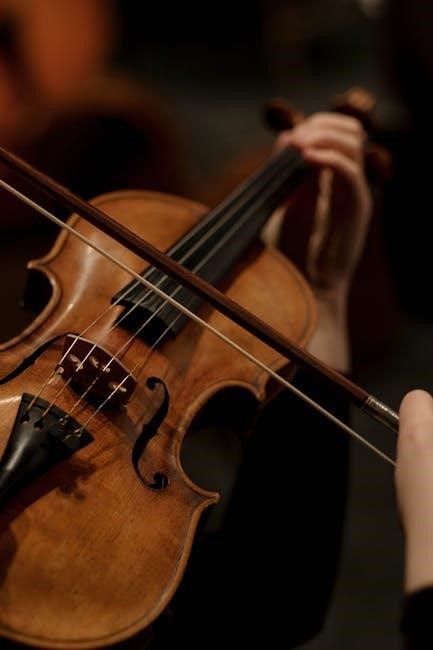
Cultural and Historical Significance
Chopin’s Prelude in E Minor‚ Op. 28‚ No. 4‚ holds a revered place in classical music‚ embodying the emotional depth and compositional brilliance of the Romantic era.
Chopin’s Legacy in Classical Music
Chopin’s Prelude in E Minor‚ Op. 28‚ No. 4‚ stands as a testament to his enduring influence on classical music. This piece‚ like much of his work‚ revolutionized piano composition by blending technical brilliance with profound emotional depth. Chopin’s innovative use of harmony and melody set a new standard for Romantic-era music‚ inspiring generations of composers. His ability to evoke intimate‚ personal feelings through music has made his works timeless. The Prelude in E Minor‚ with its haunting beauty‚ remains a cornerstone of classical repertoire‚ performed and admired worldwide. Chopin’s legacy is not only in his compositions but also in the way he redefined the piano’s expressive possibilities‚ leaving an indelible mark on the world of music.
Impact on Modern Music and Art
Chopin’s Prelude in E Minor has profoundly influenced modern music and art‚ continuing to inspire contemporary artists and composers. Its emotional depth and structural complexity provide a rich foundation for reinterpretation and innovation. Modern musicians often draw upon Chopin’s harmonic mastery and expressive nuances‚ integrating these elements into various genres‚ from pop to electronic music. The prelude’s dramatic qualities make it a popular choice for film soundtracks and art installations‚ enhancing emotional impact in visual and auditory experiences. Additionally‚ its widespread availability in sheet music formats encourages diverse arrangements and covers‚ allowing new generations to connect with and reimagine Chopin’s timeless work. This enduring influence underscores the prelude’s role as a bridge between classical tradition and modern creative expression.
Popularity in Media and Film
Chopin’s Prelude in E Minor has become a staple in media and film‚ frequently featured in movies‚ TV shows‚ and documentaries. Its hauntingly beautiful melody and emotional depth create a powerful backdrop for dramatic and reflective scenes. The piece’s universality and evocative qualities make it a popular choice for directors seeking to evoke introspection or melancholy. Additionally‚ its availability as sheet music in PDF format has made it easily accessible for filmmakers and musicians to incorporate into soundtracks. This widespread use has further cemented its place in popular culture‚ introducing Chopin’s work to new audiences and ensuring its enduring relevance in modern media.
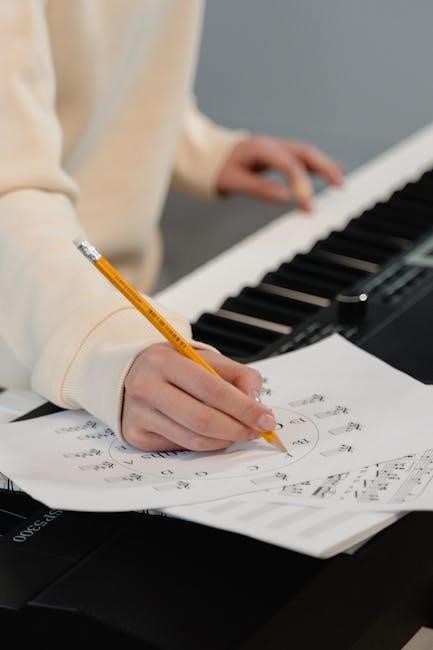
Downloading and Printing the Sheet Music
The prelude is widely available as a free PDF download. Users can easily print it from sources like pianostreet.com for personal use‚ ensuring high-quality output.
Steps to Download the PDF
To download Chopin’s Prelude in E Minor (Op. 28‚ No. 4) as a PDF‚ visit reputable sources like pianostreet.com or other trusted sheet music websites. Search for “Chopin Prelude in E Minor Op. 28 No. 4” to find the piece. Select the desired arrangement‚ such as the piano solo version‚ and click the download link. Some sites may require creating a free account or verifying your email. Once downloaded‚ the PDF can be saved to your device for easy access. Ensure the file is printed on high-quality paper for optimal readability. This process provides a convenient way to access and perform the prelude‚ making it ideal for both practice and performance purposes.
Printing Tips for Best Quality
For optimal printing of Chopin’s Prelude in E Minor (Op. 28‚ No. 4) sheet music‚ use high-quality paper with a minimum of 100 gsm to ensure clarity and durability; Set your printer to its highest DPI setting for crisp text and notes. Avoid draft mode‚ as it may compromise readability. Print in landscape orientation to match the original sheet music format and prevent awkward page turns. Adjust margins to minimize wasted space while keeping the music legible. If possible‚ use a laser printer for sharper details. Double-check page scaling options to ensure the music prints at 100% size. Finally‚ consider binding or using sheet protectors to keep your printed copy clean and secure during practice or performance.
Legal Considerations for Usage
Chopin’s Prelude in E Minor (Op. 28‚ No. 4) is in the public domain‚ meaning its original composition is free from copyright restrictions. However‚ specific sheet music editions or arrangements may be copyrighted‚ requiring permission for commercial use. Ensure that any downloaded PDF respects the rights of editors or arrangers. Personal and educational use is generally permissible‚ but commercial distribution or performance may necessitate licensing. Always verify the source and terms of use for the sheet music file. Respect copyright laws and the rights of publishers or creators of specific editions to avoid legal disputes. For unclear cases‚ consult a legal expert or seek permission from the copyright holder.

Advanced Topics and Analysis
Exploring Chopin’s Prelude in E Minor involves analyzing its harmonic complexity‚ structural depth‚ and emotional resonance‚ offering insights into its technical and interpretative challenges for pianists.
Music Theory Analysis
Chopin’s Prelude in E Minor‚ Op. 28‚ No. 4‚ exhibits a profound harmonic and structural complexity. Composed in a slow Largo tempo‚ it features a somber‚ contemplative mood‚ with a focus on expressive phrasing and dynamic contrasts. The piece is built on a simple but emotionally charged melody‚ supported by intricate harmonic progressions that modulate through related keys. The left-hand accompaniment provides a steady‚ mournful bass line‚ while the right-hand melody delivers a lyrical yet poignant theme. The prelude’s harmonic richness‚ including diminished and augmented chords‚ creates a sense of tension and resolution‚ typical of Chopin’s Romantic style. Its balanced structure‚ blending simplicity with sophistication‚ makes it a cornerstone of piano repertoire‚ offering deep insights into music theory and expressive performance techniques.
Comparative Studies with Other Preludes
Chopin’s Prelude in E Minor‚ Op. 28‚ No. 4‚ stands distinct among his 24 preludes for its somber‚ reflective nature. While other preludes in the set‚ such as the dramatic C Minor or the lyrical D-flat Major‚ showcase contrasting moods and technical virtuosity‚ the E Minor prelude is notable for its simplicity and emotional depth. Its slow‚ lamenting melody and harmonic richness set it apart‚ offering a profound exploration of melancholy. Comparative studies reveal how Chopin uses similar structural frameworks across the preludes but infuses each with unique character. This piece‚ in particular‚ highlights his ability to convey deep emotion through minimalistic means‚ making it a compelling subject for analysis alongside its counterparts in the Op. 28 collection.
Historical Performance Practices
Chopin’s Prelude in E Minor‚ Op. 28‚ No. 4‚ reflects the composer’s emphasis on expressive nuance and interpretative freedom. Historically‚ pianists have approached the piece with attention to its Largo tempo‚ emphasizing a slow‚ solemn pace that aligns with Chopin’s own performance style. The use of rubato‚ a flexible tempo adjustment‚ was a hallmark of Romantic-era interpretations‚ allowing for heightened emotional expression. Additionally‚ Chopin’s dynamic markings‚ such as the pianissimo sections‚ were often performed with delicate restraint‚ contrasting with the dramatic flourishes of his contemporaries. The prelude’s harmonic sophistication and melodic simplicity have led to varied interpretations‚ but its historical roots in Chopin’s intimate salons and personal performances remain central to its artistic identity.
Chopin’s Prelude in E Minor‚ Op. 28‚ No. 4‚ remains a timeless masterpiece‚ celebrated for its emotional depth and technical beauty. Its availability in PDF sheet music ensures its continued exploration and appreciation by pianists and music enthusiasts worldwide.
Final Thoughts on the Prelude
Chopin’s Prelude in E Minor‚ Op. 28‚ No. 4‚ is a profound and evocative piece that continues to captivate audiences with its emotional depth and technical brilliance. Its slow‚ expressive tempo and intricate harmonies make it a favorite among pianists and music enthusiasts alike. The widespread availability of sheet music in PDF format ensures that this masterpiece remains accessible for study and performance. The prelude’s enduring popularity is a testament to Chopin’s genius‚ as it transcends time and resonates deeply with listeners. Its influence extends beyond classical music‚ inspiring adaptations and interpretations across various artistic mediums. For those exploring this piece‚ whether as a performer or enthusiast‚ the Prelude in E Minor offers a rich and rewarding experience that invites deeper exploration and appreciation of Chopin’s artistry.
Encouragement for Further Exploration
Exploring Chopin’s Prelude in E Minor‚ Op. 28‚ No. 4‚ is a rewarding journey for pianists and music lovers alike. With its hauntingly beautiful melody and intricate harmonies‚ this piece invites deep interpretation and emotional connection. For those seeking to delve deeper‚ numerous resources are available‚ including free PDF sheet music‚ tutorials‚ and recordings by renowned pianists. Aspiring performers can benefit from annotated versions and practice guides‚ while enthusiasts can appreciate the prelude’s cultural significance and its impact on modern music. Whether you’re refining your technique or simply immersing yourself in Chopin’s artistry‚ this prelude offers endless opportunities for growth and appreciation. Embrace the challenge and let the music guide you on a path of discovery and inspiration.